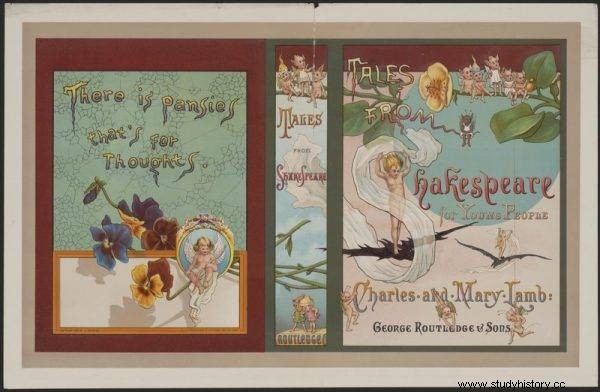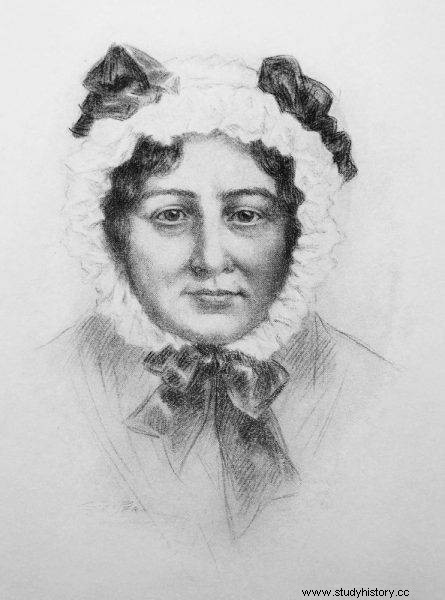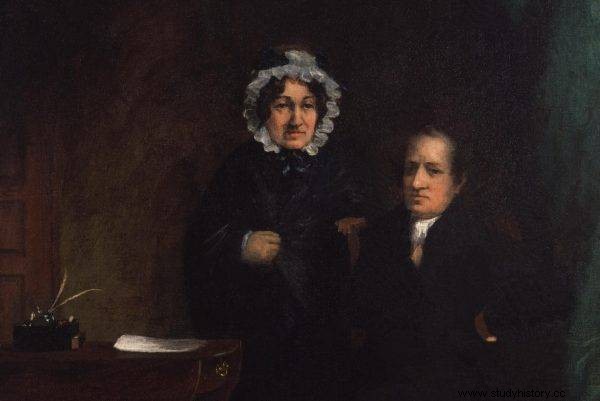Mary Lamb is known today primarily as an author of books for children. Before she began her writing career, however, she murdered her own mother in an fit of madness.
In the early fall of 1796, the inhabitants of London were struck by a monstrous crime - a 31-year-old woman in cold blood who murdered her mother for no apparent reason. The drama took place in the Holborn neighborhood on Thursday, September 22. According to the account based on the testimony of witnesses, published two days later by The Times:
(...) as the family sat down to supper, the young lady grabbed a table knife and began to chase her apprentice, a little girl, all over the room, threatening her. When the ailing mother began to call her to calm down, the daughter disregarded her at first, and then, with a loud scream, she walked closer. Meanwhile, the schoolgirl, with her cries, attracted the owner of the house, but too late.
His eyes saw a terrible picture: here the mother lay dead in a chair, stabbed to the heart, and her daughter stood over her with a fatal knife in her hand . Nearby, the old father was crying, bleeding from his forehead, as he was wounded by one of the forks with which the young lady was hurling in a fury around the room.
The horror of the situation was completed by the fact that the victim was paralyzed - she had no chance of escaping from her daughter overcome with lust for murder ...
As gentle as a lamb?
The reporter reported that the assassin's family had noticed some symptoms of madness in her a few days before her terrible outburst. Well, her brother on Thursday morning even tried to get a certain Dr. Pitcairn to her, concerned about the behavior of her sister on Wednesday evening, but did not find a doctor at home. Moreover, this was not the young woman's first fit of rage. "The jurors, of course, pronounced insanity." - this was the conclusion of the article about the Holborn tragedy.

The mad perpetrator of the crime was Mary Lamb, who went down in history as ... co-author of the children's book "Tales from Shakespeare"
The mad perpetrator of the crime was Mary Lamb, who went down in history as ... co-author of the book Tales from Shakespeare ( Shakespeare. Shakespeare in stories for young people Written in 1807, the collection contained new versions of famous works, reworked to be readable by children. Mary and her brother, Charles (the same one who failed to summon help and prevent matricide), modernized Shakespeare's style and simplified the plot a bit. Mary was supposed to be behind all the comedies in the book.
What is known about it? Mary Lamb was born in London on December 3, 1764, the third of seven children of John and Elizabeth Lamb. Apart from her, only two brothers lived to adulthood - John Junior and the aforementioned Charles, who became her closest friend. Mary's parents worked for the attorney Samuel Salt and, courtesy of him, they lived in the quiet, green district of Inner Temple. Mary attended the local school, and at the age of 14, she was educated by a seamstress. Later, even those who knew her dark past described her as gentle, prudent, rational, calm and cheerful.
The sole breadwinner of the family
After the death of the employer in 1792, the Lambs' property situation deteriorated significantly. They were forced to move. John and Elizabeth also began to decline in health. He lost the use of his left hand as a result of a stroke. She - possibly due to arthritis - suffered from overwhelming pain and ended up paralyzed. The care of her sick mother fell on Mary. Additionally, the girl had to look after her aunt Sarah Lamb. To make ends meet, she started sewing dresses. At the time of the crime, Mary was the only breadwinner of the family. Lisa Appignanesi describes:
She made dresses from dawn to dusk. She often ended up late in the evening and then went to bed in the same bed with her paralyzed mother, who never showed her warm feelings. This tedious daily routine contributed to the seizure of tormenting Mary in the winter of 1794 and 1795.

The care of the sick mother fell to Mary. Additionally, the girl had to look after her aunt Sarah Lamb.
Interestingly, Mary was not the only person in the family suffering from a mental disorder. At the end of 1795, her brother too was overcome with "temporary madness" and "melancholy". Eventually, he voluntarily moved to the Hoxton insane asylum for six weeks. On that memorable September 22, it was Charles who had snatched the bloodied knife from Mary's hand. What happened next?
Today, Mary Lamb would probably be sent to a psychiatric ward in a prison, but in England at the turn of the 18th and 19th centuries she was considered crazy and after several months in the Fisher House insane asylum in Islington, she was released. Admittedly, the woman later ended up in various similar institutions several times, but otherwise she could lead a peaceful and fruitful life. The law at that time allowed madmen to leave the closed facility, "if they were provided with appropriate care as part of the security." And this was the commitment of 21-year-old Charles. From then on, the siblings became almost inseparable.
A shaky balance
My brother reported to friends that Mary "regained her senses" on October 3, only two weeks after the murder. As he claimed, the "blur" of the sister's mind resulted from not knowing the maternal warmth. Whatever it was, Mary never committed an attack of madness again after leaving Fisher House although she suffered from a relapse at least once a year. Appignanesi reports:
As far as we know, the attacks of the disease came mainly from fatigue, excitement from over-visitors, news of deaths, or memories of the mother. Whenever his sister's condition worsened, in the first few years Charles sent her to one of the Hoxton insane asylums . Both learned to recognize the harbingers of relapse and could prepare in advance.

Charles remained faithful to Mary until the end of his life.
Charles remained faithful to Mary for the rest of his life. In periods of better health, they devoted themselves to writing together. After Tales by Shakespeare was published Mary decided to devote herself to creating children's literature. Together with Charles, they released a collection of stories Mrs. Leicester’s School and a volume of poems Poems for Children .
Happiness in misfortune
Brother and sister were to swear to each other not to marry while the latter was alive. Ultimately, they both remained alone. Charles, whose sister care became more and more overwhelming, was seeking an escape in alcohol. Shortly before Christmas 1834, he injured himself while walking drunk in Edmonton, not far from the psychiatric facility where they lived. He got blood poisoned and died a week later.
Mary lived for another 13 years. Interestingly, she did not break down after her brother's death. On the contrary, she was surprisingly well for the first three years. Later, however, the bouts of madness returned with redoubled strength. She died on May 20, 1847 at the age of 82. She was buried next to Charles in the Middlesex Cemetery. After all, she was very lucky. Had she committed her crime a few years later, her life would have been completely different. As Appignanesi concludes:
Under a new law passed in 1800, Mary Lamb, who had never again resorted to violence, would not be able to enjoy her freedom, even if her brother had pledged to take care of her, and even dozens of private psychiatric hospitals wanted to accommodate her.
Bibliography
- L. Appignanesi, Crazy, Bad and Sad. Women and Psychiatrists , Margins 2021.
- S. Burton, A Double Life:A Biography of Charles and Mary Lamb , Viking 2003.
- S.T. Hitchcock, Mad Mary Lamb:lunacy and murder in literary London , W.W. Norton 2006.
